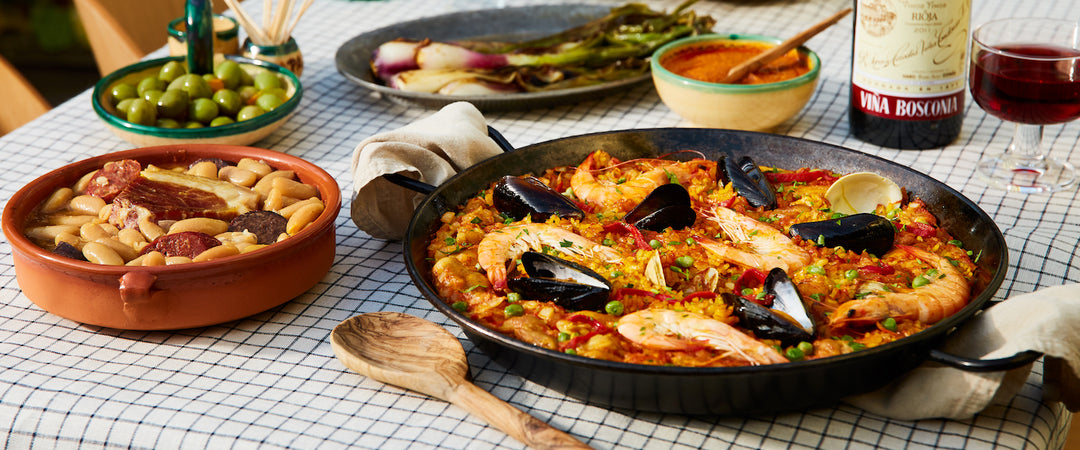September 2024 Crianza Club
 
|
Zilla Mina Spanish Red WineRegular Price: $13.99
Club Price: $ 11.89
|
Whereas the Black Slate Porrera wine felt like it required a deep and serious writeup to do the wine justice, this wine is all about light-heartedness. I mean, the label's protagonist is a young lady in a stripy body-hugger tube-top dress, nonchalantly roasting her bbq skewer (or is it a Spanish S'more?) in the flames emanating from her baby dragon's mouth. In other, darker versions of history, the dragon demands a virginal sacrifice. This is nicely contradicted here by the young lady using the dragon, who happens to be wearing matching horizontal stripes, as a sort of outdoor kitchen appliance without so much as singing a single hair on her legs! Zilla Mina, your own personal bbq? This, quite frankly, along with an importer's nicely rounded catalogue of wines, is what initially caught our eye.
Wines from the Alicante area are not very common, so that was also a reason we thought we'd give this a whirl. The label's lighthearted, maybe slightly frivolous tone is appropriate for what the wine is - a raspberry juice colored gem, full of black forest fruit and touch of spice, best enjoyed cold. It bubbles forth (figuratively, not literally) with berry flavors, backed by a little bit of backbone. Maybe Spain's answer to Beaujolais? Or maybe something to put in your picnic basket for grilling on SF's Chrissy Field grills or a Russian River romp during the coming warm weeks. Maybe not a wine where you ponder millions of years of slate geology, but the perfect companion to 45 minutes of quaffable warm weather fun. And if you absolutely must know technical details, it's made from organic Monastrell grapes. Edgy wine shop Leon & Son clear across the country in Brooklyn, NY, succinctly matched it to foods with a dry "Pizza Night, Red Sauce, Fried Food" classification. With elevated fire danger in the fall, use the dragon responsibly, please.
BMS
 |
Black Slate PorreraRegular Price: $26.99
Club Price: $22.94
|
The type of rock on which the vines for this wine grow make up two of the three words of its name. That makes it impossible to talk about this wine without a bit of a geeky deep dive into geology. Slate is a rock that is formed from fine grained sediment containing ash or mud that initially forms finely layered so-called mudstones or shales. Both of these are soft, brittle rocks. As these are buried under hundreds or possibly thousands of feet of rock above it, and heated by being underground, they consolidate into what is called a metamorphic rock. It is still layered, but the minerals have metamorphosed, hardening and changing the rock's properties. Different types of mineral content can give the resulting Slate different colors, ranging from grey, to red, to black. As the rock is lifted back up to the surface and exposed, it often weathers, cleaves into pieces at sharp angles. This is the case in Catalonia's Priorat region, where the soil formed by the sharded slate is called Licorella. As opposed to organic rich clay soils, licorella is extremely lean. The vines' roots have to bury very deep in search of both water and nutrients, creating the kind of stress that reduces grape yields per vine and results in very concentrated flavors in the fruit. As Dutch wine blogger Goswijn Simons details in his nice piece "The Secret of Priorat: LLicorella?", it is scientifically debated and in question whether the mineral composition in the soil "makes it" into the bottle. What is clear that no matter how, the Licorella soil in Priorat has a key influence on the flavor of the grape and the wine. An additional feature of the slate is that it absorbs heat during the day, then radiates it at night, essentially ensuring very even ripening and higher sugar levels despite Priorat's higher elevations. The occurences of slate in Priorat are by no means uniform. Different locations have highly variable proportions of weathering and soil, therefore variations from one village to the next can make a substantial difference in the character of the wine. Our September choice is from Porrera, one of the "famous" villages of the Priorat, as defined by the Consell Reguladores (https://www.doqpriorat.org/en/the-villages/). With the famous cliche of a picture being worth a thousand words, the following photos (courtesy of Eric Salomon wines) demonstrate the dizzying variety of soil conditions in this area. Actually, around Cellar Cal Pla's vineyard, Schist, a slighter harder even more metamorphic rock is most common.

The rusty schist of Mas D'En Cacador (photo courtesy European Cellars/Eric Solomon)

The schist of Mas D'En Compte (photo courtesy European Cellars/Eric Solomon)

The Village of Porrera (photo courtesy Istock)
Other famous neighbor villages often found on labels are Gratallops, Scala Dei, and Poboleda.
The maker of this wine is Celler Cal Pla, with winemaker Joan Sangenis in charge of the winemaking. According to the family history detailed by European Cellars, "Joan Sangenís is descended from eight generations of unruly locals who farmed various crops in Porrera. His family started making wine in 1814, and until 1996, they sold their wines in bulk to the village residents and the local cooperative. Joan’s parents, Jaume and Mercé, who both still tend to the family’s vines, purchased Mas d’En Compte in 1988, greatly expanding their vineyard land. Along with this purchase came an ancient, ruined house in the village they renovated, intending to bottle their own wines. With many of their newly-purchased vineyards having been poorly maintained, they began to revive, regraft and replant their sites while awaiting the return of their son, Joan, who was finishing his studies in enology. Upon his return to Porrera in 1996, Celler Cal Pla was born." Revival is the story of much of Spain's vineyards, and Celler Cal Pla is no exception.

Celler del Pla (photo courtesy European Cellars/Eric Solomon)
The most common grapes in Priorat are Garnacha, Carinyena, Syrah, and some Cabernet, and many estates blend very different proportions of these grapes. Black Slate Porrera is a blend of Garnatxa Negra, Carinyena, and Cabernet Sauvigon from 20-30 year old vines growing at 900-1500 ft altitudes. The grapes are hand harvested, partially de-stemmed, then undergo a natural yeast fermentation in tank and concrete and a 30 day maceration. The wine is then aged 12 months in 3-7 year old, 225L and 300L, French and Hungarian oak barrels. It is vegan, meaning no animal byproducts are used in fining or filtering.
Over the years, this modestly priced bottling has consistently garnered reviewers accolades, scoring no lower than 90, and often climbing into the 95 point range. This vintage gets our two thumbs up. Rich and jammy, ripe and opulent, this wine unleashes what millions of years have put into the slate: tons of flavor. In a region where some of the village wines command upward of $100 prices, this is a seriously delicious wine at a fraction of this price. If you like this, there are other wines in this series, each illustrating different locales and their soil types. This Porrera edition highlights dark fruit compote, dried rose petals, cassis and is a wonderful reminder that Priorat is a region worth exploring because of its amazing diversity. Pairs well with a slate board filled with charcuterie and cheeses from Spain.
BMS



